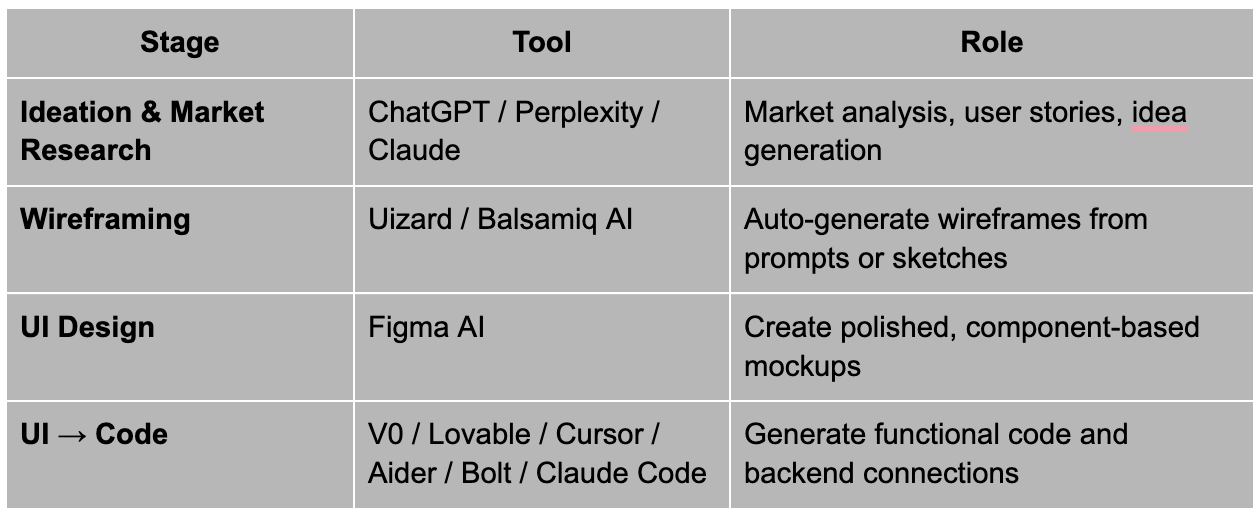
As a Product Specialists, one of the most exciting things we have been doing lately is utilising AI to build prototypes rapidly. We have been actively integrating AI into our daily product workflows and, most importantly, aligning our mental models with this new reality.
Our main goal? Turn ideas into value for customers as quickly as possible. That means getting from concept to prototype, sometimes even production-ready, in hours, not weeks.
From concept to working product
When we receive a client proposal or have an internal product idea, AI is involved immediately. We start with rapid market research using ChatGPT, Claude, or Perplexity to understand the context - market dynamics, competitors, tech trends, customer expectations.
The key is understanding value deeply before building anything. We need to know how the product fits the market and ties back to company goals. This strategic work happens fast with AI, letting us focus on connecting insights to execution.
For one of our clients in urban mobility, we use ChatGPT for weekly competitor updates, technology trends, policy changes, and city events that affect their customers. This keeps our strategy current without manual research.
Design and development in parallel
Once we understand the market, we identify the key screens or flows that deliver immediate value. We don’t design everything upfront - just what we need to bring the core experience to life.
Tools like Figma AI and V0 help us explore UI components and build clickable mockups quickly. But the creative decisions about user experience still require human judgment. AI accelerates ideation, but human creativity shapes how we actually solve customer problems.
We focus our time on the critical user journeys while using AI to generate basic components for the rest. Once we have the first iteration, we refine what matters most for value delivery.
Moving from design to code happens immediately. Using Cursor, I can write and expand code quickly, often connecting the frontend directly to Supabase for an instant backend. The result is a functional prototype that can be demoed to customers or deployed for real testing.
The right tools for each stage
We are shifting toward a world where Product Managers are not just thinkers, they are builders too.
With tools like Uizard, V0, Bolt, Cursor, Supabase, and AI agents like Aider or Cline, we can own the full process, from discovery to prototype, while pulling in expertise from other team members as needed. This doesn’t replace collaboration, it reshapes it. It amplifies ownership and speeds up execution
We’re already living this at Whitesmith. These tools are letting us ship faster, iterate more, and spend more time thinking about the right problems instead of waiting around for implementation.

Real example: 2-Hour healthcare prototype
Our hackathons are the important moments to learn, test and build using AI tools. In the latest hackathon, I used the 2 hours to focus on project we were proposing to a client.
The strategic homework was already done, so my goal for the hackathon was simple: ship a first version that validates the assumptions.
Process:
- Mapped user journeys in Uizard
- Built UI in V0
- Coded functionality in Cursor
- Connected to Supabase backend
Result: Working prototype in 2 hours, not a wireframe, an actual functioning product.
This changes customer conversations completely. Instead of debating hypotheticals, we iterate on something real.
Obviously we need to compromise the engineering part but that was intentional and documented for future improvement.
The partnership: Human & AI
AI handles routine work, but human expertise drives the decisions that matter. We bring in designers for UX validation and engineers for code reviews when needed. The goal isn’t automation for its own sake, it’s clarity and intention in what we build.
Speed alone isn’t the goal. For early-stage concepts, we accept technical debt to move fast. For high-risk products with regulatory constraints, we slow down and involve senior engineers from the start. Context determines the approach.
With AI, we can run 3-4 iterations of a product in a single day, test assumptions faster, and spend more time on strategy instead of waiting for implementation. That’s the real value - using both AI and human creativity for what each does best.
The Non-Technical Founders survival guide
How to spot, avoid & recover from 7 start-up scuppering traps.
The Non-Technical Founders survival guide: How to spot, avoid & recover from 7 start-up scuppering traps.
